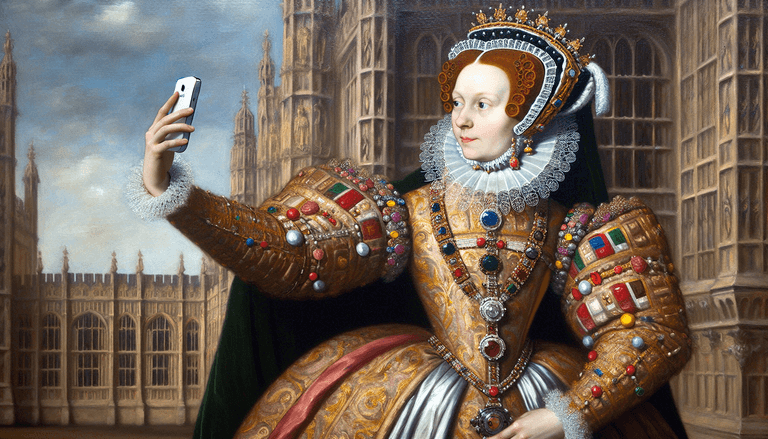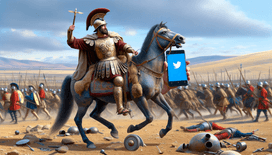Ah, the Elizabethan Era, a time when the glow of candles lit up the grandiose corridors of power while Shakespeare jotted down sonnets by the barrel load. But what if Her Majesty herself, Queen Elizabeth I, had access to something a tad more luminous – say, an Instagram account?
Selfies of the Sovereign
Picture this: Queen Elizabeth “Gloriana” Tudor, decked out in her iconic ruff, snapping selfies with her favourite courtiers. The caption? "Feeling ruff but ruling rough! 👑 #VirginQueen #ElizabethanEra". Her followers, a mélange of sixteenth-century nobility and curious commoners, would adore her style insights and musings on sovereignty.
And who better to curate the perfect Instagram feed than the queen who ruled over both a country and the fashion trends of the last decades of the 1500s. Each post, meticulously hashtagged, might read something like: "New design for royal gowns – lace, embroidery, and staying unattached! #SingleAndSceptred #Fashion"
Annexing the Algorithm
Queen Elizabeth, no stranger to the political machinations of the day, would surely navigate the social media queendom with aplomb. With the help of astute advisors like Sir Francis Walsingham, her spymaster who could double as a social media analyst, she’d introduce policy announcements via Instagram stories, swiping up to improve literacy rates or solidifying naval power against Spain.
Her taciturn demeanour in the face of international affairs would translate into cryptically-captioned posts. "Conquering foes without tottering on my throne – a true Protestant work ethic! #DefenderOfTheFaith"
The Spanish Armada: A Story Highlight
One cannot overlook a major highlight: the defeat of the Spanish Armada. Imagine the day unfolding through a series of gripping Instagram stories: timelapse videos of storm clouds brewing over the Channel, rapid-fire uploads of plucky English commanders rallying their ships, with a final repost from a defeated Spanish account: "El viento inglés – ¡madre mía! 🌪️ #StormsWillBeStorms".
Indeed, such real-time updates could democratise information, forging a new path in public engagement unseen in a period dominated by letters sealed with wax. The trusty feathered messenger supplanted by swift swipes and taps.
The Courthouse Comments Section
Of course, to moderate a tumultuous comments section would be akin to ruling a courtroom squabble. Courtiers like Robert Dudley might leave flirty replies: "Your Majesty, your beauty shines brighter than a thousand Armada beacons! 💘". While those less enchanted by the royal visage, perhaps a distant cousin eyeing the throne, might mutter passive-aggressively: "Not all that glitters is gold! #TurmoilInTudorTower".
A digital forum such as this would allow Elizabeth to measure her popularity and potentially alter public opinion, even backtracking with the occasional post deletion or edit, lest her earlier misjudgements are committed to digital eternity.
Diplomacy in DMs
Elizabeth’s diplomacy, often as sharp as her quills, could be extended to private dialogues. Direct Messages (DMs) serve as secret scrolls, opening clandestine conversations with suitors like Ivan the Terrible: "To wed or not to wed, that is the question, dear Ivan! 😜. Let's not rush into things." Some exchanges remain shrouded in mystery, much like her own personal marital status – always a topic of speculation both rooted in her own strategic reticence and extensively explored in popular tabloid pamphlets.
Imagining the Uninstagrammed
Though Elizabeth may have thrived with Instagram as a tool of engagement, one must wonder: would it have been her realm or her ruin? With her wit, charm, and political dexterity, she may indeed have mastered the art of the subtweet and the hashtag rebellion. But, as with all things digital (and various Tudor reigns), ephemerality marches alongside permanence, as transient as a fleeting Renaissance comet.
And so, as we swipe through this vision of Elizabeth’s virtual reign, we leave with a reminder that while the modes may have changed, the essence remains the same – a monarch’s reign, whether posted, pinned, or parchment-penned, ultimately rests on their sovereign shoulders.







